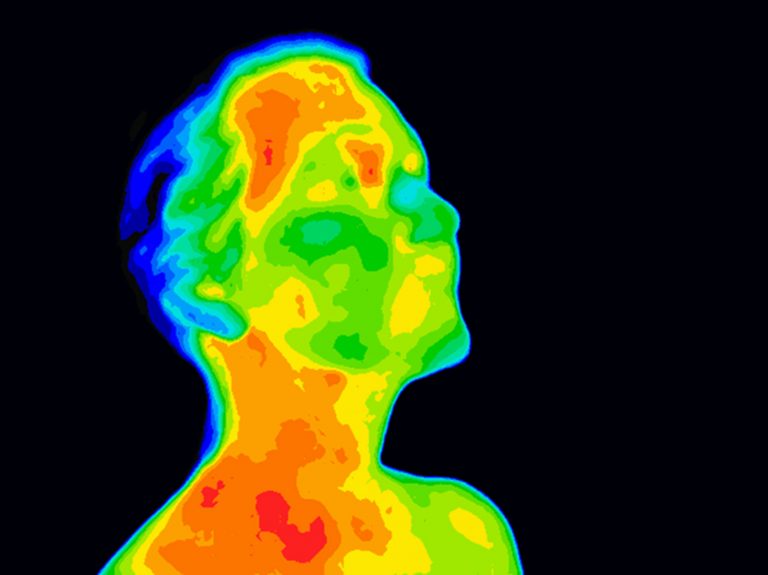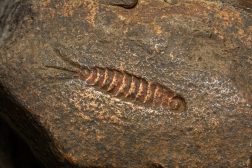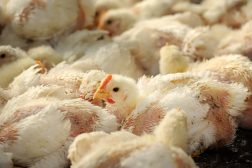Regulation of Organic Metabolism, Growth and Energy Balance

Thermographic image of face and neck indicating body temperature differences as indicated by the ranging colors — from blue cold to red hot.
Table of Contents
Organic Metabolism
Events of Absorptive and Post-absorptive States. The absorptive state is the period during which ingested nutrients enter the blood and some of these nutrients supply the energy need of the body while the remainder is stored. Post-absorptive state is the period during which the GI tract is empty of nutrients and body stores must supply the required energy.
Absorptive state
Carbohydrates and proteins are absorbed primarily as monosaccharides and amino acids, respectively, into the blood while fat is absorbed as triacylglycerols into the lymph.
- Absorbed carbohydrates. During the absorptive state, glucose is the major energy source and some of it is converted to glycogen and stored in skeletal muscle and liver. In adipose tissue, glucose is transformed and stored as fat.
- Absorbed triacylglycerols. Fatty acids of plasma chylomicrons are released within adipose tissue capillaries and form triacylglycerols.
- Absorbed amino acids. Most amino acids enter cells and are used to synthesize proteins and any excess amino acids are converted to carbohydrate or fat.
Postabsorptive state
In this state, the net synthesis of glycogen, fat, and protein ceases, and net catabolism of these substances begins. Plasma glucose level is maintained by:
- Glycogenolysis, which is the hydrolysis of glycogen stores in liver and skeletal muscles.
- Lipolysis, catabolism of triacylglycerols into glycerol and fatty acids in adipose tissues. Any glycerol reaching the liver is converted to glucose.
- Protein is catabolized to glucose.
- Such new synthesis of glucose is called gluconeogenesis.
- Glucose Sparing (Fat Utilization). Glucose sparing means the reduction of glucose catabolism and increase in fat utilization by most tissues. This spares glucose for the brain and thus protein breakdown is minimized.
Endocrine and neural control
- Insulin. A peptide hormone secreted by beta (B) cells of islets of Langerhans, in the pancreas. Its secretion is increased during the absorptive state and decreased during the post-absorptive state. Insulin targets are muscular, adipose and liver tissues. The main roles of insulin are to stimulate the movement of glucose from extracellular fluid into cells by facilitated diffusion, stimulate glycogen synthesis and inhibit glycogen catabolism. Insulin is controlled by an increase in plasma glucose or amino acid concentration, and the hormone glucose-dependent insulinotropic peptide (GIP), which is secreted in the GI tract to stimulate insulin secretion. Parasympathetic fibers stimulate insulin secretion.
- Glucagon. Glucagon is a peptide hormone secreted by alpha (A) cells of the pancreas. Its target is the liver tissue and its actions are opposed to that of insulin. Glucagon increases glycogen breakdown and gluconeogenesis to increase the plasma concentration of glucose during the post-absorptive state or when plasma glucose is low (hypoglycemia). Sympathetic nerves stimulate glucagon secretion. On a side note, cortisol and growth hormone also have effects similar to that of glucagon.
Diabetes mellitus & hypoglycemia
Diabetes mellitus results from a deficiency of insulin or hyporesponsiveness (slowed response) to insulin.
In insulin-dependent diabetes mellitus (IDDM) or type 1 diabetes, insulin is very low or absent as a result of the destruction of beta cells. Large amounts of glucose are excreted as the plasma glucose level is very high and the filtered load of glucose exceeds the maximum tubular reabsorptive capacity. Treatment must involve the administration of insulin. In noninsulin-dependent diabetes mellitus (NIDDM) or type 2 diabetes, the plasma insulin level is normal but there is target-cell hyporesponsiveness to insulin, termed insulin resistance, which is also related to obesity.
Hypoglycemia refers to a condition characterized by a low plasma glucose level. This condition could arise from an excess of insulin (beta cells) or a deficiency of glucagon (alpha cells).
Regulation of plasma cholesterol
The two sources of cholesterol are diet and synthesis by the liver. The liver also excretes cholesterol by adding it to bile. The homeostatic control that keeps the plasma cholesterol constant mainly involves hepatic synthesis.
The ingestion of saturated fatty acids (animal fats) raises plasma cholesterol while unsaturated fatty acids (vegetable fats) lowers it. Low-density lipoproteins (LDL) deliver cholesterol to cells throughout body while high-density lipoproteins (HDL) removes excess cholesterol from blood and tissue and delivers it to the liver for excretion. The ratio of LDL to HDL is important and the lower the ratio, the lower the deposition of extra cholesterol in the blood vessels.
Growth Regulators
Two major regulators of growth are (1) environmental factors and (2) hormonal influences. Environmental factors imply the need for adequate nutrient supply for growth. Apart from outside factors, growth is also regulated by hormones. Some of the hormones influencing growth are as follows:
- Growth hormone and insulin-like growth factors. Growth hormone (GH), secreted by the anterior pituitary, is the single most important hormone for postnatal growth. An excess of GH produces gigantism, whereas a deficiency produces dwarfism. When excess GH produces bone thickening without lengthening and overgrowth of other organs, it is called acromegaly. GH exerts its effect on growth by promoting secretion of IGF-I from the liver and other tissues. IGF-I promotes cell division and stimulates protein synthesis by promoting the uptake of amino acids by cells.
- Thyroid hormone. Thyroid hormone (TH) is important for controlling metabolism and plays a permissive role in the normal development and maintenance of the nervous system. A decrease in TH during infancy leads to mental retardation, called endemic cretinism.
- Insulin. Insulin is an anabolic (building) hormone and inhibits protein degradation. It also promotes cell division and differentiation because it is required for the production of IGF-I.
- Sex hormones. Sex hormones stimulate the secretion of GH and IGF-I. Testosterone exerts an anabolic effect by stimulating protein synthesis.
- Cortisol. Cortisol exerts antigrowth effects by stimulating protein catabolism (breakdown).
Energy Balance
Concepts of energy expenditure
The breakdown of organic molecules liberates the energy stored in their bonds. The energy produced is used by cells to perform biological work – muscle contraction (external work) and active transport, molecular synthesis (internal work).
The energy that is liberated (ΔE) during the breakdown of an organic molecule can either appear as heat (H) or be used to perform work (W).
ΔE=H+W
Energy for work must first be incorporated into ATP. Heat cannot be converted to work but is used to maintain body temperature and thus homeostasis.
Metabolic rate
The metabolic rate is the total energy expenditure per unit time. Basal metabolic rate (BMR) is the metabolic rate under certain standardized conditions (the subject is at mental and physical rest in a room at a comfortable temperature and has not eaten for 12 hours). Most of the activity contributing to basal metabolic rate is from the activity of the heart, liver, kidney, and brain.
Thyroid hormones
Thyroid hormones are the most important determinant of BMR. They can increase BMR by increasing oxygen consumption and heat-production in most body tissues, which is termed a calorigenic effect, by reducing ATP production.
Epinephrine
Epinephrine increases metabolic rate by calorigenic effect. Epinephrine stimulates the catabolism of glycogen and triacylglycerols.
Food-induced thermogenesis
Ingestion of food raises body temperature and protein has the greatest effect in producing temperature changes.
Muscle activity
Muscle activity increases muscle contraction, e.g., during exercise or shivering, which in turn increases the metabolic rate.
Regulation of total-body energy stores
Energy stored = Energy from food intake – (Internal heat produced + External work)
The bodyweight of adults is regulated around a set point by reflexively adjusting caloric intake and/or energy expenditure.
Control of food intake
A hormone, leptin, synthesized by adipose tissue, is released in proportion to the amount of fat in adipose tissue. The hormone acts on the hypothalamus to cause a reduction in food intake by inhibiting the release of a neuropeptide that stimulates eating. It also stimulates the metabolic rate and therefore controls changes in energy expenditure. Leptin is important in long-term control.
In short-term, various satiety signals such as insulin, body temperature, presence of food in GI tract act on the hypothalamus to regulate the duration and frequency of meals..
Overweight and obesity
Overweight is a term to describe an increased amount of fat in the body and obesity is the state of being excessively overweight. The body mass index (BMI) is an index of weight and is calculated by dividing a person’s weight by the square of their height. Low-calorie diets have limited effectiveness to control weight since it results in a drop in metabolic rate, preventing further weight loss. Exercise, however, lowers the set-point around which total body stores of fat are regulated. Exercise is an effective method, over time, in managing weight and body fat stores.
Eating disorders
Anorexia nervosa is the pathological fear of gaining weight and consequent reduction of food intake. This disorder leads to low blood pressure, low body temperature and altered secretion of many hormones and a severe case may lead to death. Bulimia is recurrent episodes of binge eating associated with self-induced vomiting, laxatives, diuretics, dieting or exercise in order to rid the body of ingested food.
Regulation of body temperature
The ability to maintain body temperatures within narrow limits is called homeothermy. The total heat content of the body is the net difference between heat production and heat loss. In steady-state, heat production equals heat loss. The body surface can lose heat by radiation, conduction, convection and by the evaporation of water.
Temperature-regulating reflexes
Changes in body temperature are detected by two types of thermoreceptors, ones in the skin (peripheral thermoreceptors) and ones in the hypothalamus, spinal cord, etc. (central thermoreceptors). Central thermoreceptors provide the essential negative feedback for maintenance of core body temperature while peripheral thermoreceptors provide feedforward information.
The hypothalamus serves as the overall integrator of reflexes and sends outputs via sympathetic nerves to sweat glands, skin arterioles, and adrenal medulla and via motor neurons to skeletal muscles.
Control of heat production
Changes in muscle activity constitute the major control of heat production and a decrease in core body temperature leads to an increase in skeletal muscle contraction, which then leads to shivering (rhythmical muscle contractions). No external work is performed by shivering and all liberated energy appears as internal heat, called shivering thermogenesis. Voluntary muscle contractions are also used to produce heat.
Control of heat loss by radiation and conduction
The skin’s effectiveness as an insulator is subject to physiological control by a change in blood flow to the skin cells. As more blood reaches the skin from the core the closer the two temperatures become. Blood vessels reduce the insulating capacity of skin by carrying heat to the surface to be lost to the external environment. Vasoconstrictor sympathetic nerves, firing of which is increased in response to cold and decreased in response to heat, control these vessels. Behavioral mechanisms, such as curling up into a ball when cold, reduce the surface area exposed to the environment, thus decreasing heat loss by radiation and conduction.
Control of heat loss by evaporation
Water loss through skin, sweat and respiratory tract can also contribute to heat loss.
Integration of effector mechanisms
The range of environmental temperatures over which body temperature can be maintained by vasoconstriction or vasodilation alone is called the thermoneutral zone. Below and above this zone, the body must increase its heat production and increase heat loss respectively.
Temperature acclimatization
Changes in sweating onset, volume, and composition determine adaptation to high temperatures. Sodium loss through sweat is reduced by its increased reabsorption due to aldosterone secretion.
Fever and hyperthermia
Fever is the elevation of body temperature due to a resetting of the thermostat in the hypothalamus. Body temperature is always maintained during a fever. Fevers are caused by infection or stress. The raising of the body thermostat results in the overall sensation of feeling cold. Vasoconstriction and shivering occur to drive up body temperature. When the thermostat is reset and the fever breaks, it leads to a person feeling hot, vasodilation and sweating occurs. Sometimes this process is referred to as fever and chills.
The thermostat is reset by chemical messengers, called endogenous pyrogen (EP), which consists of interleukin 1 (IL-1) and IL6. Both of which are released from macrophages, acting upon the hypothalamus. Excessive and potentially damaging fever is prevented and the temperature is brought back to normal.
Increased body temperature stimulates defensive responses to infection. An elevation in body temperature not due to infection is called hyperthermia. Exercise and retention of heat is a common cause.
Heat exhaustion and heat stroke
Heat exhaustion is a state of collapse due to hypotension from: (1) depletion of plasma volume secondary to sweating, resulting in decreased cardiac output and (2) extreme dilation of skin blood vessels resulting in decreased peripheral resistance. It is a safety device to force cessation of work in a hot environment when heat loss mechanisms are overtaxed, preventing a large rise in body temperature.
Heat Stroke is a complete breakdown of heat-regulating systems so that the body temperature keeps going up. It is characterized by collapse, delirium, seizures, and unconsciousness. Heatstroke occurs due to overexertion in hot environments. It works in a positive feedback manner, raising body temperature, increasing metabolism and producing still further heat.
You will also like...

Takahē (Porphyrio hochstetteri)
Meet the colorful takahē, an extremely rare flightless bird. Find out more about its unique features and why they matte..

Mammalian Ancestors
Mammals are a diverse group of organisms, where most of them develop their offspring within the uterus of the mother. Ov..

Developmental Biology
Developmental biology is a biological science that is primarily concerned with how a living thing grows and attains matu..

Insects
There are more species of insects than any other species combined. This surely illustrates that insects have the selecti..

New Zealand’s Unique Geographical History
Explore why New Zealand has such unique flora and fauna, and learn why long periods of geographical isolation. This less..

Selective Breeding
Gregor Mendel's studies into Monohybrid and Dihybrid crossing and Charles Darwin's study of evolution and natural select..
